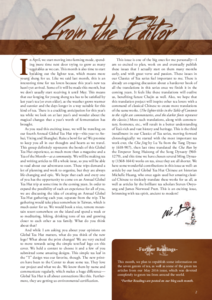
 |
|

In April, we start moving into farming mode, spending more time next door trying to grow as many vegetables as we can. This month is also time to start breaking out the lighter teas, which means more young sheng for us. Like we said last month, this is an interesting time for tea lovers because this year's new tea hasn't yet arrived. Some of it will be made this month, but we don't usually start receiving it until May. This means that our longing for young sheng tea has to be satisfied by last year's tea (or even older), as the weather grows warmer and sunnier and the days longer in a way suitable for this kind of tea. There is a crackling anticipation for this year's tea while we look on at last year's and wonder about the magical changes that a year's worth of fermentation has brought.
As you read this exciting issue, we will be traveling on our fourth Annual Global Tea Hut trip - this year to Anhui, Yixing and Shanghai. Raise a bowl for us! We promise to keep you all in our thoughts and hearts as we travel. This group definitely represents the bonds of this Global Tea Hut experience, as much more than a magazine and a Tea of the Month - as a community. We will be making tea and writing articles to fill a whole issue, so you will be able to read about our adventures soon. These trips demand a lot of planning and work to organize, but they are always life-changing and epic. We hope that each and every one of you has the opportunity to come on an Annual Global Tea Hut trip at some time in the coming years. In order to expand the possibility of such an experience for all of you, we are discussing the idea of creating an Annual Global Tea Hut gathering each year, separate from the trip. The gathering would take place somewhere in Taiwan, which is much easier for us. We would book a nice, remote mountain resort somewhere on the island and spend a week or so meditating, hiking, drinking tons of tea and growing closer to each other as tea family. What do you think about that?
And while I am asking you about your opinions on Global Tea Hut matters, what do you think of the new logo? What about the print changes? We are very excited to move towards using the simple text/leaf logo on this cover. We held a contest to choose it and a few of you submitted some amazing designs. This simple tea leaf in the "T" design was our favorite, though. The new printers have been to the Center to share some tea. They love our project and what we do. We know them by name and communicate regularly, which makes a huge difference - Global Tea Hut is all about connections like this. Furthermore, they are getting us environmental certification.
This issue is one of the big ones for me personally - I am so excited to plan, work on and eventually publish these issues that I actually start on them many months early, and with great verve and passion. These issues in our Classics of Tea series feel important to me. There is already an ongoing discussion about a hardcover book of all the translations in this series once we finish it in the coming years. It feels like these translations will outlive us, benefiting future Chajin as well. Also, we hope that this translation project will inspire other tea lovers with a command of classical Chinese to create more translations of the same works. (The lighter titles in the Table of Contents to the right are commentaries, and the darker fonts represent the classics.) More such translations, along with commentary, footnotes, etc., will result in a better understanding of Tea's rich and vast history and heritage. This is the third installment in our Classics of Tea series, moving forward chronologically: we started with the most important tea work ever, the Cha Jing by Lu Yu from the Tang Dynasty (618-907), then last time translated the Cha Run by the Emperor Song Huizong of the Song Dynasty (9601279), and this time we have chosen several Ming Dynasty (1368-1644) works on tea, since they are all shorter. We have some wonderful contributions in this issue as well: an article by our local Global Tea Hut Chinese art historian Michelle Huang, who once again used her amazing classical Chinese to tirelessly translate these works for us all, as well as articles by the brilliant tea scholars Steven Owyoung and James Norwood Pratt. This is an exciting issue, brimming with tea spirit, ancient to modern!

This month, we plan to republish some information on the seven genres of tea, as well as some of the green tea articles from our May 2016 issue, which was devoted completely to green tea from around the world.